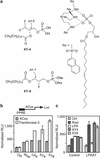Identification of an intracellular receptor for lysophosphatidic acid (LPA): LPA is a transcellular PPARgamma agonist
- PMID: 12502787
- PMCID: PMC140905
- DOI: 10.1073/pnas.0135855100
Identification of an intracellular receptor for lysophosphatidic acid (LPA): LPA is a transcellular PPARgamma agonist
Erratum in
- Proc Natl Acad Sci U S A. 2003 Feb 18;100(4):2163
Abstract
Lysophosphatidic acid (LPA) is a pluripotent lipid mediator acting through plasma membrane-associated LPA(x) receptors that transduce many, but not all, of its effects. We identify peroxisome proliferator-activated receptor gamma (PPARgamma) as an intracellular receptor for LPA. The transcription factor PPARgamma is activated by several lipid ligands, but agonists derived from physiologic signaling pathways are unknown. We show that LPA, but not its precursor phosphatidic acid, displaces the drug rosiglitazone from the ligand-binding pocket of PPARgamma. LPA and novel LPA analogs we made stimulated expression of a PPAR-responsive element reporter and the endogenous PPARgamma-controlled gene CD36, and induced monocyte lipid accumulation from oxidized low-density lipoprotein via the CD36 scavenger receptor. The synthetic LPA analogs were effective PPARgamma agonists, but were poor ones for LPA(1), LPA(2), or LPA(3) receptor transfected cells. Transfection studies in yeast, which lack nuclear hormone and LPA(x) receptors, show that LPA directly activates PPARgamma. A major growth factor of serum is LPA generated by thrombin-activated platelets, and media from activated platelets stimulated PPARgamma function in transfected RAW264.7 macrophages. This function was suppressed by ectopic LPA-acyltransferase expression. LPA is a physiologic PPARgamma ligand, placing PPARgamma in a signaling pathway, and PPARgamma is the first intracellular receptor identified for LPA. Moreover, LPA produced by stimulated plasma platelets activates PPARgamma in nucleated cells.
Figures





References
-
- Goetzl E J, Lee H, Dolezalova H, Kalli K R, Conover C A, Hu Y L, Azuma T, Stossel T P, Karliner J S, Jaffe R B. Ann NY Acad Sci. 2000;905:177–187. - PubMed
-
- Moolenaar W H. J Biol Chem. 1995;270:12949–12952. - PubMed
-
- Fang X, Gaudette D, Furui T, Mao M, Estrella V, Eder A, Pustilnik T, Sasagawa T, Lapushin R, Yu S, et al. Ann NY Acad Sci. 2000;905:188–208. - PubMed
-
- Pages G, Girard A, Jeanneton O, Barbe P, Wolf C, Lafontan M, Valet P, Saulnier-Blache J S. Ann NY Acad Sci. 2000;905:159–164. - PubMed
-
- Sano T, Baker D L, Virag T, Wada A, Yatomi Y, Kobayashi T, Igarashi Y, Tigyi G J. J Biol Chem. 2002;277:21197–21206. - PubMed
Publication types
MeSH terms
Substances
Grants and funding
LinkOut - more resources
Full Text Sources
Other Literature Sources
Molecular Biology Databases
Miscellaneous

